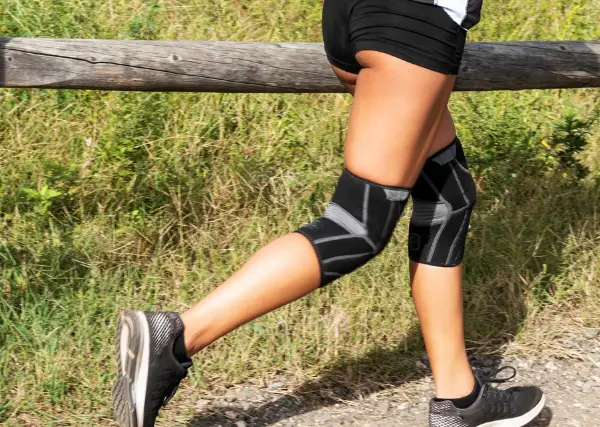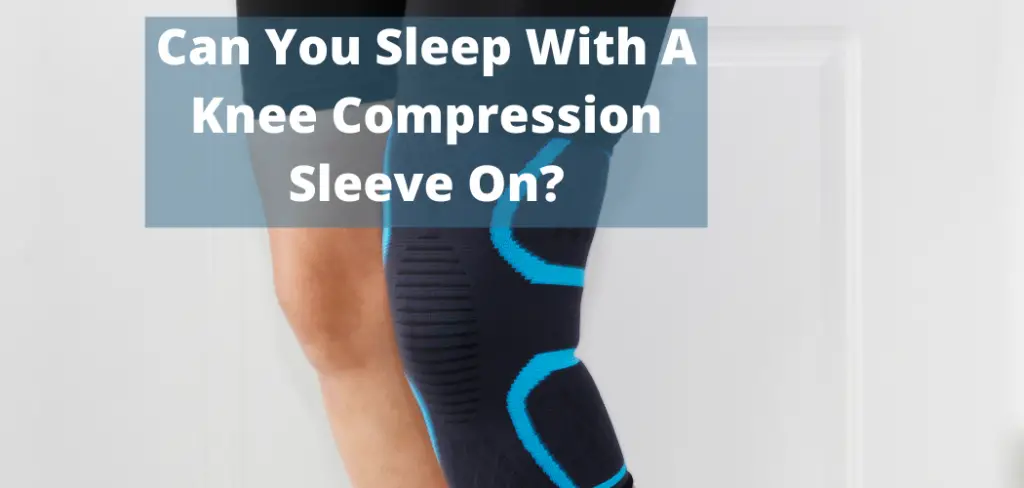Knee compression sleeves are great alternatives to a knee brace because they offer more mobility while keeping your leg and knee protected. Doctors often recommend them after you are ready to ditch the brace post-surgery or when you have a knee injury that needs just a little bit of support through recovery but doesn’t require a brace.
Yes, you can sleep with a knee compression sleeve on but you probably don’t need to sleep with one for your recovery. You may need to adjust your sleeping positions to sleep on your side or back if you sleep with a knee compression sleeve on.
You will also need pillows to remain comfortable and reduce knee pain. You will also need to make sure your knee compression sleeve fits exactly to avoid circulation issues.

Read on to find out how to best sleep with a knee compression sleeve and also some things you should be careful about when using them overnight.
Why Compression Knee Sleeves Work
A knee compression sleeve can reduce joint swelling and stabilize it so you can move better. It helps with minor injuries but is also used to reduce pain from arthritis.
It is easier to use than a brace because you can move comfortably in it while it offers some overall support to your knee and leg.

One of the reasons a knee compression sleeve is effective in reducing pain and protecting the knee is because it’s made using a Neoprene material. This special fabric retains heat, which regulates blood flow, reduces stiffness, and increases mobility.
What Are the Benefits of Wearing a Compression Sleep While Sleeping?
A knee compression sleeve can do many of the same things a brace can including protecting your knee from injury.
It can keep you from accidentally twisting it or moving your knee too much while you are sleeping. It also will support you if you have to get up in the middle of the night to use the bathroom or get a snack.
A knee compression sleeve is a good idea for those recovering from injury who tend to sleep deeply. They could inadvertently twist their knew in the night with a movement without realizing it.
One of the other benefits is that it keeps your knee warm through the night with consistent blood flow. We need more blood flow to heal and we tend to heal the most while we’re sleeping. After new injuries, this is a good time to keep the knee warm and keep good blood flow for healing.

Finally, the knee compression sleeve can help with swelling. If wake up with considerable swelling in the mornings then a compression sleeve can help. The compression helps prevent and manage swelling through the night.
Overall, a compression sleeve can reduce knee pain to help you sleep. This isn’t meant to be a long-term solution but can help you while your knee is recovering from an injury or surgery.
Best Positions to Sleep With Knee Pain
Some sleep positions are better than others for those with chronic knee pain. No matter which you prefer, we recommend using comfort aids such as extra pillows, ice packs, and hot packs.
Sleeping on your side
This is a good position for those who detest sleeping on their back. You can stretch your legs out or bend them more. If you have knee pain we recommend using a knee pillow to put between your knees to reduce pressure.


It is also best if you lay on the side of your good knee, so your injured knee is on top. That will ensure there is no pressure placed on that knee. However, you will likely have to switch sides multiple times through the night and this is just fine.
Sleeping on your back
The best position, from your knee’s standpoint, is sleeping on your back. You can keep your knee straight and still in this position. You will need a pillow or two under both your knees to get into the most comfortable position.
We also recommend using sleeping wedges to find that perfect and most comfortable sleeping position. You place them underneath the knees and behind the back to get the best night’s sleep with all the aches and pains. This is perfect if you also suffer from back pain.


It may also make it more comfortable to put a rolled-up towel or neck roll between your neck and your pillow.
What to Avoid When Wearing a Knee Support to Bed
There are a few cautions about wearing a knee compression sleeve to bed.
- First, you don’t want it too tight because that will cut off your leg circulation so make sure you don’t have any numbness or tingling in the feet.
- You also don’t want it too loose or have the ability to slide down your leg. A compression sleeve can bunch up and that causes a tourniquet effect, cutting off circulation.
- Be careful with open, uncovered wounds. You don’t want to cover those with a compression sleeve because it could cause irritation and infection.
- Those with little to no feeling in their legs or who have peripheral neuropathy shouldn’t wear a compression sleeve to bed.
FAQ
Can you wear a compression sleeve all day?
It’s safe to wear it all day but your knee will need a break. Take short breaks from it throughout the day while you are resting.
As a rule of thumb, only use a knee brace as long as you need but not more than you have to.
Can you get a rash from a compression sleeve?
Rashes can occur if you are constantly wearing the compression sleeve and especially if it goes several days without a wash.
Remember, you sweat and your skin has bacteria that can grow and that gets trapped with the sleeve.
How long should you wear a knee compression sleeve?
While you can wear it all day, it’s best to only wear it when you are active like participating in a sports activity, physical therapy, or at work.
You don’t want to start relying on it because eventually you will be taken off it as your knee recovers.
Can you sleep with an Ace bandage on?
Ace bandages are a good substitute for knee compression sleeves at night. You can use them regularly for support while you sleep but just be sure they aren’t too tight. Otherwise, they will cut off circulation.
Conclusion
You can absolutely sleeve with a knee compression sleeve on and at times this is even a good idea to prevent more swelling and to keep the joint warm.
However, you only want to wear a knee brace or a compression sleeve when you need it.
Let us know if you like to wear a compression sleeve in the comments below and any other tips for sleeping with knee pain.
Disclaimer: The information provided in this post is for educational purposes only. This is not a substitute for a medical appointment. Please refer to your physician before starting any exercise program.

